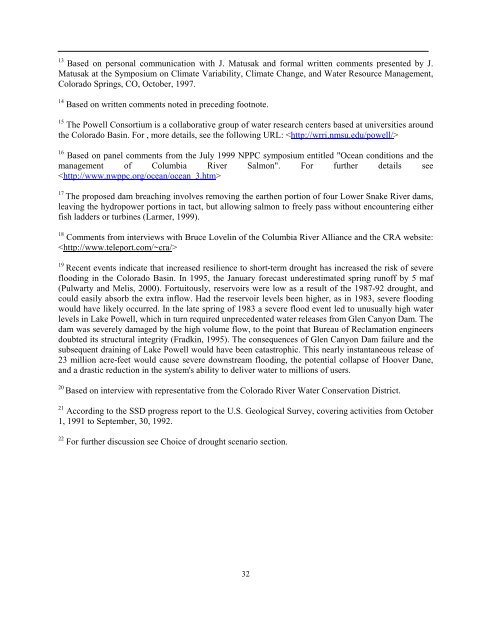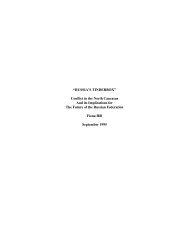Global Environmental Assessment Project - Belfer Center for ...
Global Environmental Assessment Project - Belfer Center for ...
Global Environmental Assessment Project - Belfer Center for ...
You also want an ePaper? Increase the reach of your titles
YUMPU automatically turns print PDFs into web optimized ePapers that Google loves.
13 Based on personal communication with J. Matusak and <strong>for</strong>mal written comments presented by J.<br />
Matusak at the Symposium on Climate Variability, Climate Change, and Water Resource Management,<br />
Colorado Springs, CO, October, 1997.<br />
14 Based on written comments noted in preceding footnote.<br />
15 The Powell Consortium is a collaborative group of water research centers based at universities around<br />
the Colorado Basin. For , more details, see the following URL: <br />
16 Based on panel comments from the July 1999 NPPC symposium entitled "Ocean conditions and the<br />
management of Columbia River Salmon". For further details see<br />
<br />
17 The proposed dam breaching involves removing the earthen portion of four Lower Snake River dams,<br />
leaving the hydropower portions in tact, but allowing salmon to freely pass without encountering either<br />
fish ladders or turbines (Larmer, 1999).<br />
18 Comments from interviews with Bruce Lovelin of the Columbia River Alliance and the CRA website:<br />
<br />
19 Recent events indicate that increased resilience to short-term drought has increased the risk of severe<br />
flooding in the Colorado Basin. In 1995, the January <strong>for</strong>ecast underestimated spring runoff by 5 maf<br />
(Pulwarty and Melis, 2000). Fortuitously, reservoirs were low as a result of the 1987-92 drought, and<br />
could easily absorb the extra inflow. Had the reservoir levels been higher, as in 1983, severe flooding<br />
would have likely occurred. In the late spring of 1983 a severe flood event led to unusually high water<br />
levels in Lake Powell, which in turn required unprecedented water releases from Glen Canyon Dam. The<br />
dam was severely damaged by the high volume flow, to the point that Bureau of Reclamation engineers<br />
doubted its structural integrity (Fradkin, 1995). The consequences of Glen Canyon Dam failure and the<br />
subsequent draining of Lake Powell would have been catastrophic. This nearly instantaneous release of<br />
23 million acre-feet would cause severe downstream flooding, the potential collapse of Hoover Dane,<br />
and a drastic reduction in the system's ability to deliver water to millions of users.<br />
20 Based on interview with representative from the Colorado River Water Conservation District.<br />
21 According to the SSD progress report to the U.S. Geological Survey, covering activities from October<br />
1, 1991 to September, 30, 1992.<br />
22 For further discussion see Choice of drought scenario section.<br />
32
















